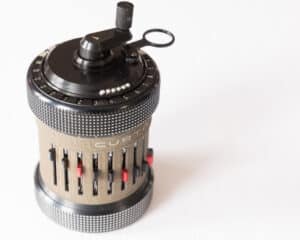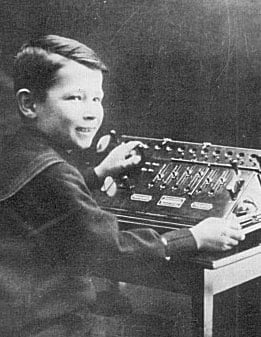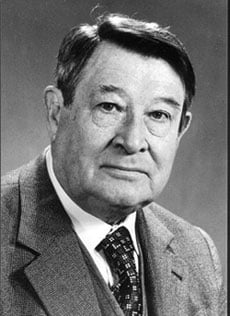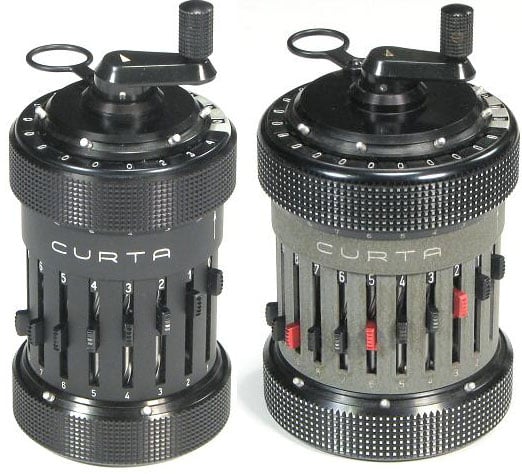
4 Facts About Curta Calculator
Some major facts about the Curta calculator are as follows:
- Due to its design and mode of operation were dubbed the “pepper grinder” or “peppermill.”
- Its apparent similarity to a particular hand grenade gained it the title “math grenade.”.
- Before getting surpassed by the electronic calculators in the 1970s, Curtas were the finest portable calculators available.
- It was small enough to fit in one hand, controlled with a single finger, and would add, subtract, multiply, and divide while also calculating powers and roots.
Curta Calculator History

Curt Herzstark’s Curta is a unique mechanical calculator developed on Lebnitz’s stepped drum mechanism. This single drum replaced the many drums seen in conventional calculators, which often number tens. It allowed addition and subtraction using nines complement math, which is effectively subtracting by adding.
When “borrowing” during subtraction, the nines’ complement arithmetic breakthrough avoided the substantial mechanical complication generated. The Curta’s miniaturization hinged on this drum. In 1938, the Nazis commanded Curt Herzstark and his company to focus on developing precise tools for the German army, which put an end to their work on the pocket calculator.
The Curta has become a renowned collectible, with numbers of machines still functioning as well as they did 40, 50, or 60 years back. Before introducing electronic calculators, commercial and general-aviation pilots preferred the Curta because of its precision and the user’s ability to validate the integrity of his or her operations using the revolution counter.

Curt Herzstark was an Austrian engineer who lived from July 26, 1902, to October 27, 1988. He made plans for a mechanical pocket calculator during WWII (the Curta). Curt studied Latin and English at a Real-gymnasium in 1916 after attending an elementary school (1908-1912) and a middle school. Then his father explained that finishing high school and wasting years studying sciences was a waste of time. Curt took a year out from school when he was 14 years old to work as an apprentice in fine machine and tool construction at his father’s firm.
Curt explored the physics of calculators even as a child. Curt, then eight years old, demonstrated an Austria calculator at the International Office Machines Exhibition at Gartenbau, Vienna, in 1910. In 1918, he enrolled in Vienna’s Staatsgewerbeschule (an engineering institution) to study die-making and precision mechanics.
Curt returned to the family business after graduating from the Staatsgewerbeschule in 1922 to gain more knowledge of the trade, but his father soon sent him to work in two factories in Chemnitz, Germany (AstraWerke (which generated a 10-key adding machine roughly comparable to Dalton) and then Wanderer (which developed automobiles, motorcycles, a woodworking machine, and an adding machine)) to acquire skills.
Curt returned to the family enterprise in Vienna in 1924 after a year in Germany. His father then sent him to the sales department, even though by then he was almost faultless in technical matters. The cause behind this was that his father thought that it was vital to be aware of the consumers’ needs. The sales groups in Czechoslovakia and Hungary were then given over to Curt to reorganize, and Curt excelled at those tasks. Curt Herzstark created his first invention in 1928 and named it Multimator.
It was a multi-summator, a machine capable of adding horizontal and vertical columns in the calculating mechanism automatically in one operation. The machine was first shown to the public at an international office machine expo in Berlin, where it caused quite a stir.
Curt began working on designs for a small cylindrical calculating machine by the mid-1930s, and by 1938, he had submitted a major patent, Deutsches Reichspatent No747073, for his supplemented stepped drum.
In the autumn of 1937, Herzstark died. Hitler’s soldiers invaded Austria only a few months later (in March 1938). Then a huge sedan stopped in front of the factory two months later, and five people got out. The business was already in bad shape. Later, two of the men were Wehrmacht officers, while the rest were precision mechanics experts. They were looking for a company that could produce high-precision military machines.
Herzstark had already finalized the layout of the Curta while working as the technical manager of his father’s company Rechenmaschinenwerk AUSTRIA Herzstark & Co. in 1938, but due to the Nazi German invasion of Austria, he was unable to build it.
His health was jeopardized when he was imprisoned at Buchenwald, but it recovered when he was assigned to work in the camp’s factory. He was later asked to produce a diagram of his calculator’s construction so that the Nazis might send the machine to the Führer as a gift if the war ended successfully. Because of the special treatment he received as a result of this, he was able to stay at Buchenwald until 1945, when the camp was liberated, by which time he had redrawn the entire structure from memory.
Curta Calculator: How It Worked
The fundamental design is a pepper-pot-shaped metal barrel with a winding handle at the top and a ring pull next to it. To perform the computations, spin the handle, or crank, clockwise. A set of tiny levers or slides can be lifted up and down around the barrel to create the numbers you want to calculate.
Two sets of corresponding numbers are displayed at the top: the black numbers on a white background represent the number of times the handle has been turned to perform the calculations. The white numbers on a black background represent the calculation result.
In simple words, you have to input the first number, crank, and then lift the handle to activate the subtraction function. There’s the solution if you crank again. To multiply, simply enter the number and keep cranking until the display on the upper edge of the Curta shows the number of times you’ve turned.
The Curta was produced in two basic models: Curta Type I (see the left lower image) and Type II (right image).

Curta Model I (left image) and Type II (right image)
In the table bellow you can see some details about Type I and Type II Curta models:
| Model | Type I | Type II |
| “Entry/Counter/Results” Readouts | 8 x 6 x 11 | 11 x 8 x 15 |
| Data Entry Register (Multiplicand) | 8 digits | 11 digits |
| Crank Turns Counter (Multiplier) | 6 digits | 8 digits |
| Result Register (Product) | 11 digits | 15 digits |
| Add or Multiply to | 11 places | 15 places |
| Divide To | 6 places | 8 places |
| Diameter | 53 mm | 65 mm |
| Height | 85 mm | 90 mm |
| Weight | 230 g | 360 g |
Despite the bad management of the Contina A.G., an estimated 150000 Curta calculators have been made until 1972 (some 85000 Type I and some 65000 Type II). The initially estimated world demand of 3 to 4 million pieces was not nearly reached.
Curtas were very practical and useful devices, and were very popular, especially in the surveying industry and engineering. A book of tables and a Curta in its metal can could easily be taken into the field, allowing calculations to be completed and measurements verified without needing to return to the office. Many Curta calculators were purchased simply as curiosities or as objets d’art, and some of these can still be found unused in their original packaging.
The Curta proved to be a far more unique creation than the considerably larger calculating machines available at the time. It was a mechanical calculator with a compact and sturdy cylindrical shape — barely 10 cm high and weighing only 230 grams— with a column of 37 sprockets based on the Leibniz cylinder at its heart. It had been optimized by Herzstark to perform a wide range of mathematical operations with an accuracy of 11 digits.
Curtas were extremely practical and helpful instruments widely used, particularly in the surveying and engineering industries. A book of tables and a Curta in its metal container could be transported into the field and used to finish computations and verify measurements without returning to the office.